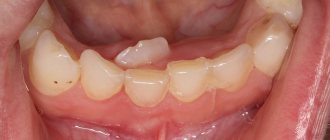Changing children's baby teeth to permanent ones is always an exciting time for parents. This process is quite lengthy and often painful for the child, because it can be accompanied by various inflammations and discomfort. To help parents, for a better understanding of the physiological processes associated with the formation of teeth, dentists offer to look at the pattern of loss of baby teeth in children.
Bookmarking teeth
The formation of baby teeth occurs at approximately 4-6 weeks of fetal development. At the same time, the formation of the fundamental elements occurs much later - during the first months of the child’s life. For this reason, new mothers who are bottle-feeding are strongly recommended to supplement their baby’s diet with calcium. This substance promotes the proper formation of tooth enamel.
At an early age, unprotected baby teeth are extremely susceptible to carious lesions. Parents should monitor this closely, as infection can subsequently cause destruction of permanent teeth. The fact is that the rudiments of permanent teeth are in close proximity to the roots of milk teeth, so as soon as you discover dark spots on your child’s enamel, immediately go to pediatric dentistry.
Names of teeth, their types
Incisors, canines, premolars and molars make up the dental arch. To make it easier to remember, the teeth were numbered from 1 to 8:
- 1 and 2 - incisors;
- 3 - fangs;
- 4 and 5 - premolars;
- 6, 7, 8 - molars.
Having examined and delved into the numbering and names, you understand what kind of teeth a person has. But each tooth has its own specific functions and is responsible for certain processes during eating.
For example, the incisors give a person the ability to bite off pieces of food; fangs help capture food; premolars and molars help grind food and make our cheekbones more aesthetic, as they have an angular position.
Baby teeth in children: loss pattern
Many mothers are concerned about the question of when their children’s baby teeth begin to fall out. As a rule, this process starts immediately before primary school, that is, at the age of 6-7 years. In this case, the pattern of loss of baby teeth in children is similar to the sequence of their eruption. Only the fangs differ, which are replaced later, by the age of 13.
The order in which baby teeth fall out is the same for almost all children. First, molars grow - molars, which were absent in the “milk” set. As soon as there is enough space in the child’s jaw, “sixes” begin to appear. Only after this comes the time to change temporary teeth.
First, the lower incisors fall out, and then the upper ones. After this, the premolars appear at about 9-11 years of age. The last in line are the fangs, which usually fall out by the age of 10-12 years. At the same time, there should already be molars in the child’s mouth. After 18 years, third molars or, as we used to call them, wisdom teeth begin to emerge. However, they do not appear in everyone, which, by the way, does not indicate the presence of any pathologies.
Teething order
Diagram of the eruption of baby teeth (numbered in order of priority)
Finding out the sequence of teeth appearance in children will be useful for young parents who have already felt the joy of becoming a mother and father, or this is still to come in the future. By the end of the first year, children have several teeth. The number is determined by a number of factors. One reason is heredity.
Problems in the baby’s body that arise as a result of:
- low calcium content in the body and the formation of rickets.
- dysfunction of the thyroid gland and, as a result, a decrease in hormones in the blood.
- absence of incisors (edentia).
- dysfunction of the gastrointestinal tract.
Baby teeth
While still in the womb, the rudiments of dental formations are formed in the fetus. And by the middle of pregnancy, the required number and order of appearance of one or another incisor is formed.
It must be taken into account that a child’s oral bone formations should number 20. The time of eruption of baby teeth and the order are of a purely individual nature. However, there are generally accepted norms, which are an indicator of the correct physiological development of the baby. So how do children usually grow their teeth? Let's take a closer look at this topic.
First tooth
In babies, the first pair of teeth appears on the lower jaw. Which tooth of a given pair should appear first? Pediatricians say that teeth can erupt at the same time or with an interval of several days. And you shouldn’t worry about which incisor appeared first, because there are no special rules for this. Usually, young parents are happy to see their child’s first tooth appear at 6-7 months of his life. But at the same time, the scope of the norm expands significantly - from 4 to 9 months.
Second pair
Following the growth of the lower incisors, the upper ones should appear. The order in which the right or left incisor appears first does not matter. The interval between their occurrence can vary from several hours to two weeks.
According to statistics, the upper incisor appears first on the side from which the lower one appeared. The upper teeth normally erupt at 5-11 months. Usually at eight months.
Third pair
How does a child’s teeth continue to grow? After the child begins to smile with his 4 teeth, his lateral incisors, which are located on the upper jaw, appear. The third pair of bone formations appears at 10 months. Medical experts consider it normal for these teeth to erupt from 7 months to a year.
Fourth pair
The lower lateral incisors appear between 9 and 15 months.
The child's next teeth are the upper and lower molars. Normally, they appear before the fangs. But in recent years, doctors have increasingly encountered exceptions when the canines form first. And after 2-3 months, the lower molars are also replenished in the mouth.
Molars begin to grow at the age of 1-1.5 years. Let us immediately note that molars are large formations and their eruption is accompanied by high fever, lack of appetite and capriciousness of the child.
The next stage of the teething scheme is given to the canines. Fangs usually appear between the ages of one and a half to two years. But there are cases when they are formed earlier than paired molars.
Fangs, like painters, make themselves felt through the manifestation of the following symptoms: pain and itching of the gums, symptoms of rhinitis, changes in stool. These signs disappear as soon as a new tooth appears.
The second group of upper and lower molars erupt painlessly and asymptomatically at 2-3 years. This group is the final one in the chain of primary (non-permanent) teeth. After the milky bone formations of the oral cavity begin to fall out, permanent teeth will grow.
Generally accepted teething pattern
Children at 2.5 years old should have 4 incisors and 4 molars, as well as 2 canines. This scheme looks like this: 2-1-2 (2 incisors, 1 canine, 2 molars grow from above and below from each half of the jaw).
In order to determine the normality of a child’s teeth, a special formula is provided. The calculation is carried out as follows: the number of teeth should correspond to the difference in the age of the baby in months and six. For example, at 1.5 years (17 months) this number is 11 (17-6=11). The method for determining the required number of teeth is more appropriate to use for children under two years of age, then the formula will be more accurate.
First teeth: symptoms of their eruption
The progress of teething is usually accompanied by certain symptoms. These signs are reflected in behavior and emotional state. The following manifestations are considered normal:
- secretion of saliva in large quantities. This symptom usually appears at the end of 2 months and can last up to 4.
- looseness and hyperemia of the gums – lasts for quite a long time.
- skin irritation in the lips and chin area. The appearance of an allergic reaction is caused by excessive salivation. To prevent irritation on the baby's delicate skin, parents should wipe his mouth more often and lubricate the skin with baby cream. For better absorption of the cream, it is better to apply it at night.
- The gums turn red and begin to itch. This manifests itself when the baby is breastfeeding, because he bites the nipple.
- the presence of pain disrupts the baby's sleep. For some time he will not be able to fall asleep on time, and the duration of sleep will be shorter. During this period, some pediatricians recommend giving the baby analgesics.
- Lack of appetite and refusal to eat are common problems during the teething stage. This symptom is caused by pain when eating food. The exception is the mother's breast.
- thumb sucking or the desire to chew on something. Most often, the child puts into his mouth any object that catches his eye and begins to gnaw on it. Therefore, it is necessary to ensure that toys and other items are clean.
- hematomas or bruises - medium-sized bulges on the gums with a bluish tint. There is no need to worry about their occurrence if their number is insignificant. You can apply cold compresses to the bumps. The hematomas will gradually disappear on their own.
All of the above signs have virtually no effect on the baby’s behavior and well-being, and disappear after teeth appear.
How to help a child with incisor teeth?
As soon as the baby begins to be bothered by the symptoms associated with the manifestation of incisors, parents begin to look for ways to eliminate negative phenomena. There are many tips and recommendations from specialists that can help you survive this stage of a child’s development more easily and without any consequences.
How can I make teething easier for my baby?
- You should provide your child with objects that he can chew on. This will relieve his anxiety and massage his gums.
- For this purpose, rubber toys filled with liquid or gel filler are best suited. They are designed to achieve a cooling effect on the gums. The main disadvantage of such items is that they will have to be periodically placed in the refrigerator.
- Pacifiers or bottles. The chewing or sucking mechanism helps soothe irritated gums. It should be taken into account that regular sucking and chewing of objects with an irregular shape can cause the formation of an abnormal bite. That is why it is necessary to purchase a pacifier with a special shape and made of high-quality material.
- A finger brush is a remedy for eliminating itchy gums in a baby. Recently, it has become increasingly popular and in demand among young mothers, because in addition to its main action, the brush is an assistant in caring for the oral cavity of babies.
- At home, in the absence of special care items, it is possible to use gauze swabs, which are pre-moistened in cold water. This method simultaneously eliminates itching and cleanses the oral cavity of microorganisms. Massaging the gums with a gauze swab should be done carefully, gently, without sudden movements that can injure the oral mucosa.
- Most methods are ineffective. In extreme cases, resort to medication. Pharmaceutical companies offer a huge number of special gels and ointments for topical use. It is better to select the appropriate remedy together with your pediatrician.
What should parents do?
The process of changing teeth in children worries parents, but this is quite natural, and most children do not experience significant pain. However, this does not relieve parents of the need to constantly monitor the condition of their child’s oral cavity. There is no need to remove baby teeth yourself. When the time comes to say goodbye to a tooth, a certain mechanism is activated in the child’s body that dissolves the milk tooth roots. You should seek help from a specialist only if the baby tooth does not want to fall out, but the permanent one is already beginning to appear.
After a tooth falls out, you may experience some bleeding. If desired, have your child rinse his mouth with a solution of soda with a drop of iodine as a preventative measure.
If you have a problem similar to that described in this article, be sure to contact our specialists. Don't diagnose yourself!
Why you should call us now:
- We will answer all your questions in 3 minutes
- Free consultation
- The average work experience of doctors is 12 years
- Convenient location of clinics
Single contact phone number: +7
Make an appointment
How many teeth should a child have at 3 years old?
All twenty baby teeth appear by about 2-2.5 years. It includes eight incisors and molars, as well as four canines. By this time, they are erupting, including in the wrong direction, but by the age of three, in most cases they occupy a normal position, since the child is actively chewing food.
If by the age of three a boy or girl does not have a full set, do not panic. This may be an individual characteristic of the child. To be sure, it is advisable to consult a pediatrician and dentist to clarify the cause of the delay and rule out rickets, metabolic disorders or endocrine diseases.
How many baby teeth do children lose?
The very first teeth appear between the ages of six months and one year. First, the incisors appear, located below and in the center, then the upper ones, and only then the lower lateral and upper lateral ones. This is followed by the first molars, canines and second molars. In pediatric practice, such a concept as a dental formula is used, that is, a standard dental set for children: 2 incisors, 2 molars and a canine. Multiplying the data obtained by four, we get 20 – the number of baby teeth is normal. Accordingly, the same number of baby teeth fall out.
Dental clinic "32 Dent" offers a full range of services in the field of pediatric dentistry. To receive complete and detailed answers to all your questions, call the numbers listed on the website.
Typical problems.
The most typical problem between the ages of 3 and 6 years is the development of caries of primary teeth in the area of the first and second primary molars. The narrow interdental spaces between the first and second primary molars, which are difficult for a child to reach, are an ideal place for plaque to accumulate. As a result, caries forms on the surface of the teeth hidden from the eyes of parents (between the 4th and 5th milk teeth). Being unnoticed, the carious process quickly progresses, complicated by inflammation of the nerve of the tooth (pulpitis).
With poor oral hygiene and a large number of carious teeth, caries of the permanent molar (6th tooth) often develops, high-quality treatment of which is only possible by a pediatric dentist.
Deviations in timing and problems when changing teeth
One or another problem with the loss of baby teeth and the germination of molars occurs in at least every tenth child. Fortunately, dentists are ready to correct the bite during the growth stage, remove extra teeth, and even insert an implant if there is no point in waiting for a root one.
Let's look at the main deviations that may cause concern:
"Shark's Mouth"
Sometimes baby teeth do not have time to fall out, but the molars have already grown “second row”. The “shark’s mouth” is not worth admiring. You need to go to the dentist as soon as possible and remove unnecessary temporary teeth, otherwise your bite may be significantly damaged.
Untimely change of teeth
If the first baby teeth begin to leave the baby’s mouth before 5 years of age or after 8 years of age, then this is a deviation from the norm, which means you need to understand the reason. Trauma, caries, ecology, nutrition, congenital problems with bite or other heredity, various infectious diseases, hormonal problems (for example, thyroid disease), as well as diseases due to which the child is at risk for underdevelopment and delay may be to blame. formation of permanent dentition (diabetes, leukemia, immunodeficiency and others).
The molar does not grow in place of the lost milk tooth
There is no need to panic, but it is worth consulting with a specialist. For example, if a molar tooth does not erupt, although the baby tooth has fallen out a long time ago, the reason cannot be determined with ordinary eyes, but an x-ray will help. If there is no tooth germ in the picture, this is called adentia. This problem is extremely rare - the tooth simply has nothing to grow from. The decision will require the help of a prosthetist.
With retention, the germ of a new tooth is present, but it is directed incorrectly or is deep in the gum. All that remains is to wait for the tooth to grow. This problem occurs more often in the lower third molars, as well as in the upper incisors and canines.
With impaction, the tooth cannot come out due to the close fit of neighboring teeth. Here, too, you cannot do without the help of professionals.
We also advise you to consult a doctor if:
- molars appear darkened or grow crooked;
- the order of tooth loss and growth differs significantly from the above graphs;
- the child’s gums hurt and his cheek is swollen;
- baby tooth is corroded by caries;
- a tooth fell out, but blood from the socket does not stop oozing for more than an hour (not to be confused with ichor).
What are the features of the eruption of “temporary” teeth?
Baby teething normally occurs at six months of age. The first sign of this process is the formation of a dental tubercle on the edge of the gum. This occurs as a result of pressure on the mucous membrane - it gradually stretches, becomes thinner and a breakthrough occurs. Then you can see the edge of the crown of the new tooth above the gum. As soon as the entire crown appears above the gum cavity, this is the eruption of the tooth.
In various sources you can find exact dates for teething, but they are arbitrary. Any discrepancies with them depend on the individual developmental characteristics of the baby. There is no need to worry if your child's first tooth appears later or earlier than his peers. Teething is a natural process that occurs on an individual schedule.
Did you know that baby teeth have roots? It’s just that by the time they begin to fall out, they resolve on their own. If sometimes a tooth has to be removed before its natural loss occurs, its root can be seen.
In erupted baby teeth, the formation of roots occurs according to the following scheme:
- The formation of the roots of the incisors occurs by the age of two.
- The roots of the molars will be fully formed by the age of 4 years.
- The formation of the roots of the fangs occurs by the age of 5 years.
Is it possible to pull out a baby tooth yourself?
At home, you can remove a baby tooth only if it is well loosened and you can walk freely in the socket.
It is important that the child does not have a cold: coughing, sneezing, runny nose - these are stop signals for home removal of a baby tooth. Examine the child’s mouth - if there is swelling or bleeding of the gums, your manipulations may lead to infection in the socket. It's better to see a dentist.
If you still decide to pull out a baby tooth, it is better not to experiment with tying the object to be removed to the door handle.
The best way is this: wrap the tooth with gauze soaked in alcohol and pull it out of the hole until it comes out. The tooth can also be wrapped with sterile thread and pulled strictly perpendicular to the jaw.
After the manipulations are successful, the child needs to rinse his mouth, the parent needs to see if there are any parts of the tooth left in the socket (if the tooth is broken and something remains, you need to go to the doctor). Sterile cotton wool is placed in the hole for 20 minutes: the child must press it with his teeth to stop the bleeding. Make sure your child does not drink or eat for a couple of hours after tooth extraction.
If the tooth falls out on its own, also put cotton wool in the hole and do not let the baby drink or eat for a while.
Where to put baby teeth after they fall out?
The first tooth can be kept as a souvenir or given to the child to put in a box with children's valuables. If sentimentality is not accepted in your family, then the tooth can be thrown out.
In many families, the tooth is placed under the pillow to be taken away in exchange for a coin or small treat by the Tooth Fairy. This character came to us from the West. The fairy builds a castle from children's teeth in which good dreams are born.
But there is also a domestic tradition - to give a lost tooth to a mouse, which can also thank you with a gift. Previously, the tooth was thrown underground or hidden behind the stove with the words “Here, mouse, a bast tooth! Give me a bone one, mouse!” Now this story is more suitable for residents of private houses. It's up to you to decide whether it's worth chasing a mouse into an apartment on the 20th floor, even if it's a fabulous one. But you can take absolutely any magical character that your child likes and come up with a story about where and why the baby’s tooth will end up.
Interesting fact: baby teeth contain both stem and progenitor cells. Scientists believe that in the future, with the development of science and technology, baby teeth can be used for the benefit of their owners, for example, to treat serious diseases. But in order to preserve the cells in the tooth, special storage conditions are required, which, unfortunately, cannot be created at home.











